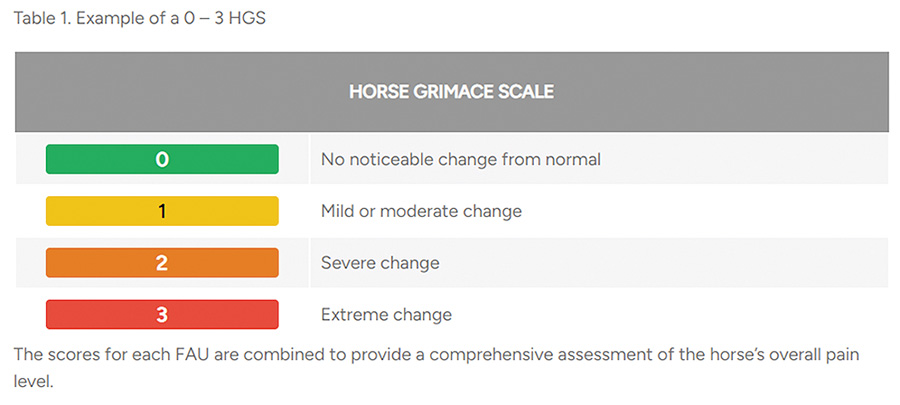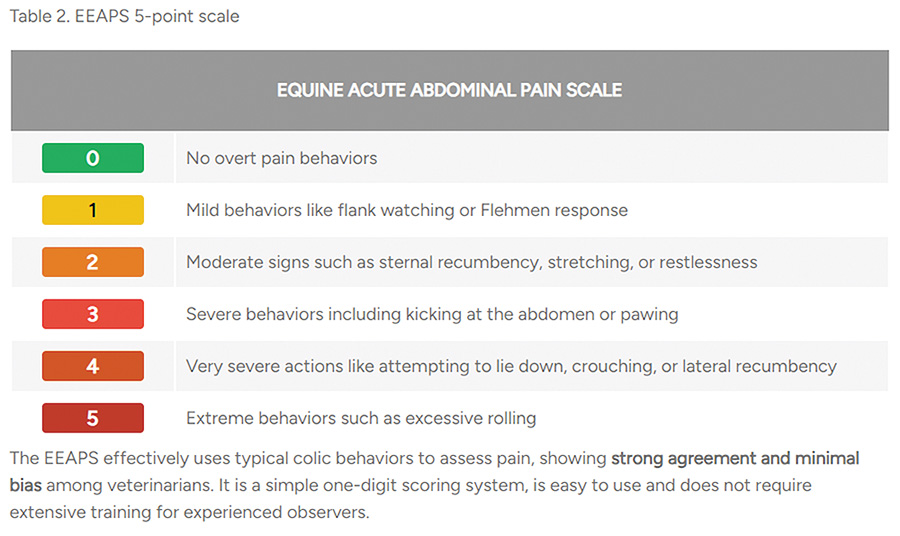
Interpreting pain in animals is inherently challenging because they cannot verbally express their discomfort.
By Camryn McNeill, B.B.R.M.
As a leader in equine nutrition science, Mad Barn thanks The Rider for featuring this story. To read the full version of this article, visit https://madbarn.com/pain-assessment-for-horses/.
Pain in horses is an uncomfortable sensory and emotional experience resulting from tissue damage or the anticipation of tissue damage. It can stem from a variety of causes, such as injuries, diseases, or surgical procedures.
Early recognition and intervention are critical to direct appropriate treatment and prevent minor issues from escalating into serious health problems.
The distinction between normal and painful behaviors is often subtle, and horses are naturally stoic, frequently masking their discomfort. This makes it difficult for owners and caretakers to detect less obvious signs of pain.
Regular veterinary evaluations and the use of pain assessment tools can provide insight into a horse’s condition.
Signs of Pain in Horses
Interpreting pain in animals is inherently challenging because they cannot verbally express their discomfort. This difficulty is amplified in prey species like horses, who instinctively hide pain and weakness to avoid appearing vulnerable to predators.
Severe pain is generally easier to identify, but it can be life-threatening if not addressed promptly. Early detection of pain, even when subtle, is crucial to prevent minor issues from escalating into critical, life-threatening situations.
This highlights the need for vigilant monitoring and regular veterinary assessments to ensure timely intervention if a horse is experiencing pain. Recognizing pain in horses involves observing both physical and behavioral signs. Indications of pain vary significantly depending on the location, type and severity of discomfort.
Behavioral Changes
Pain can cause a range of altered behaviors in horses, including:
∙ Changes in Demeanour
∙ Social Withdrawal
∙ Restlessness
∙ Changes in Eating or Drinking Habits
∙ Reluctance to Move
Physical Changes
Key physical indicators of pain include:
∙ Lameness or Altered Gait
∙ Changes in Posture
∙ Sweating Without Exertion
∙ Teeth Grinding
Changes in Vital Signs
Monitoring your horse’s heart rate, respiratory rate, and body temperature can help you track changes in health and assess pain severity.
∙ Heart Rate (HR): A normal resting heart rate for a horse ranges from 28 to 44 beats per minute (bpm). An elevated heart rate beyond this range can indicate pain or discomfort.
∙ Respiratory Rate (RR): A normal resting respiratory rate for a horse is between 10 and 24 breaths per minute. An elevated respiratory rate can indicate pain, especially when accompanied by signs of distress or agitation.
∙ Temperature: Normal body temperature for a horse ranges between 99°F and 101.5°F (37.2°C to 38.6°C).
Equine Pain Assessment
Subjective pain assessment involves evaluation based on an observer’s interpretation of a horse’s behaviour, appearance, and reactions, such as changes in movement, posture, and demeanour.
Pain Faces in Horses
A pain face is a specific, observable facial expression that indicates discomfort or pain in animals, such as horses. The Horse Grimace Scale (HGS) is a standardized tool developed to assess pain in horses through the analysis of their facial expressions.
The Horse Grimace Scale (HGS) uses a scoring system to assess pain. It rates each Facial Action Unit (FAU) based on its deviation from normal expressions, typically on a scale from 0 to 2 or 0 to 3.\ Assessment Tools for Colic
Assessment Tools for Colic
The Equine Acute Abdominal Pain Scale (EAAPS) is a systematic tool used to evaluate and quantify pain levels in horses with acute abdominal conditions like colic. It categorizes pain based on observable behaviors. Evaluating Chronic Pain
Evaluating Chronic Pain
The Horse Chronic Pain Composite Pain Scale (HCPS) is designed to evaluate and quantify chronic pain in horses. This scale integrates multiple indicators, such as facial expressions and behavioural changes, helping veterinarians better understand and manage long-term discomfort in horses.
Ridden Horse Pain Ethogram (RHPE)
The Ridden Horse Pain Ethogram (RHPE) is a detailed observational tool used by riders, trainers, and veterinarians to identify and assess musculoskeletal pain and lameness in horses during ridden work. It focuses on specific behavioural and physical indicators to provide a comprehensive evaluation of pain.

If you observe signs of pain in your horse, it is important to consult with your veterinarian to accurately diagnose the source and severity of the pain. A professional assessment is crucial to determine the appropriate treatment plan.
About the Author
Cam lives in Ontario, Canada and completed her Bachelor’s of Bio-Resource Management (B.B.R.M.) at the University of Guelph with a specialization in Equine Management. She is interested in horse welfare and understands the importance of a healthy diet for a happy horse. She has over 15 years of horse experience, having worked at lesson barns and racetracks. When she’s not studying, Cam spends the majority of her time hanging out by the lake with her dog or hitting the gym.
Source: MadBarn


